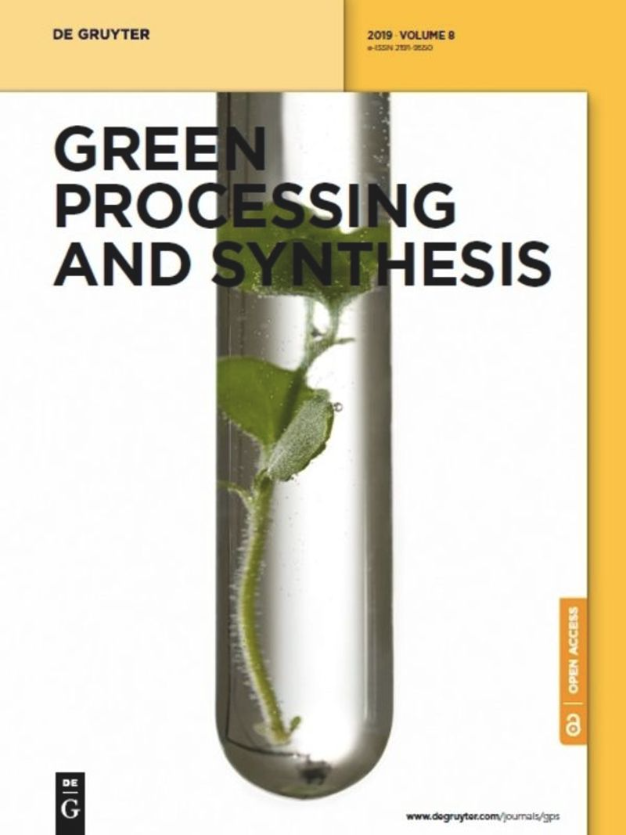黄冈胶介导的金属纳米颗粒的合成、表征及其作为杀菌剂、催化剂、抗氧化剂和过氧化物酶模拟物的应用
IF 3
4区 工程技术
Q2 CHEMISTRY, MULTIDISCIPLINARY
引用次数: 1
摘要
摘要在用于合成各种纳米颗粒(NP)的生物方法中,黄冈胶(TGC)介导的NP产生是重要的。口香糖TGC不仅符合绿色化学的原则,而且具有独特的品质。从这个角度来看,目前的综述集中在树胶的组成、用途和开发,以合成银(Ag)、金(Au)、钯(Pd)、铂(Pt)的金属NP,以及它们的表征(紫外-可见吸收光谱、X射线衍射、傅立叶变换红外光谱和透射电子显微镜)。此外,还强调了合成的NP作为杀菌剂、催化剂、抗氧化剂和过氧化物酶模拟物的应用。Ag NP(13 nm)在2–12时对革兰氏阴性菌和革兰氏阳性菌显示出抗菌作用 μg·mL−1。Ag-NP作为杀菌剂的开发使其成为药物和药理学应用的候选者。Pd-NP(14)的催化活性 nm)显示硼氢化物还原亚甲基蓝。树胶还原/封端的金属和金属氧化物NP用作氧化还原和光催化剂,用于修复工业废水中的有毒颜料和染料。15 μg·mL−1时,Pd-NP具有1,1-二苯基-2-苦基肼自由基清除活性(95.8%),可作为过氧化氢比色传感的人工模拟酶。介绍了其他TGC基纳米复合材料的工业应用,如重金属吸附、伤口敷料、药物载体、组织工程等。本文章由计算机程序翻译,如有差异,请以英文原文为准。
Gum tragacanth-mediated synthesis of metal nanoparticles, characterization, and their applications as a bactericide, catalyst, antioxidant, and peroxidase mimic
Abstract Among biogenic methods employed for synthesizing various nanoparticles (NPs), gum tragacanth (TGC)-mediated NP production is important. The gum TGC not only qualifies the principles of green chemistry but also embraces unique qualities. In this perspective, the current review concentrates on the composition, uses, and exploitation of gum towards synthesizing metal NP of silver (Ag), gold (Au), palladium (Pd), platinum (Pt), and their characterization (UV-visible absorption spectroscopy, X-ray diffraction, Fourier transform infrared spectroscopy, and transmission electron microscopy). In addition, applications of synthesized NP as a bactericide, catalyst, antioxidant, and peroxidase mimic are emphasized. Ag NP (13 nm) showed antibacterial action against Gram-negative and Gram-positive bacteria at 2–12 μg‧mL−1. The exploitation of Ag NP as a bactericide makes it a candidate of choice for medicinal and pharmacological applications. The catalytic activity of Pd NP (14 nm) demonstrated borohydride reduction of methylene blue. The gum reduced/capped metal and metal oxide NP serve as redox and photocatalysts for the remediation of toxic pigments and dyes in industrial effluents. At 15 μg‧mL−1, Pd NP exhibited 1,1-diphenyl-2-picrylhydrazyle radical scavenging activity (95.8%) and served as an artificial enzyme mimic for colorimetric sensing of hydrogen peroxide. The industrial applications of other TGC-based nanocomposites, such as heavy metal sorption, wound dressing, drug carrier, tissue engineering, etc., are mentioned.
求助全文
通过发布文献求助,成功后即可免费获取论文全文。
去求助
来源期刊

Green Processing and Synthesis
CHEMISTRY, MULTIDISCIPLINARY-ENGINEERING, CHEMICAL
CiteScore
6.70
自引率
9.30%
发文量
78
审稿时长
7 weeks
期刊介绍:
Green Processing and Synthesis is a bimonthly, peer-reviewed journal that provides up-to-date research both on fundamental as well as applied aspects of innovative green process development and chemical synthesis, giving an appropriate share to industrial views. The contributions are cutting edge, high-impact, authoritative, and provide both pros and cons of potential technologies. Green Processing and Synthesis provides a platform for scientists and engineers, especially chemists and chemical engineers, but is also open for interdisciplinary research from other areas such as physics, materials science, or catalysis.
 求助内容:
求助内容: 应助结果提醒方式:
应助结果提醒方式:


